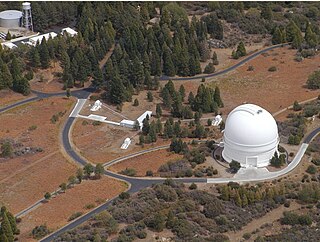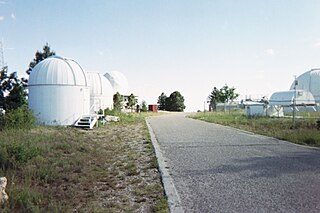Timeline of telescopes, observatories, and observing technology.

Yerkes Observatory is an astronomical observatory located in Williams Bay, Wisconsin, United States. The observatory was operated by the University of Chicago Department of Astronomy and Astrophysics from its founding in 1897 until 2018. Ownership was transferred to the non-profit Yerkes Future Foundation (YFF) in May 2020, which began millions of dollars of restoration and renovation of the historic building and grounds. Yerkes re-opened for public tours and programming in May, 2022. The April, 2024 issue of National Geographic magazine featured a story about the Observatory and ongoing work to restore it to relevance for astronomy, public science engagement and exploring big ideas through art, science, culture and landscape. The observatory offers tickets to programs and tours on its website.

The Mount Wilson Observatory (MWO) is an astronomical observatory in Los Angeles County, California, United States. The MWO is located on Mount Wilson, a 5,710-foot (1,740-meter) peak in the San Gabriel Mountains near Pasadena, northeast of Los Angeles.

Helen Battles Sawyer Hogg was an American-Canadian astronomer who pioneered research into globular clusters and variable stars. She was the first female president of several astronomical organizations and a scientist when many universities would not award scientific degrees to women. Her scientific advocacy and journalism included astronomy columns in the Toronto Star and the Journal of the Royal Astronomical Society of Canada. She was considered a "great scientist and a gracious person" over a career of sixty years.

Palomar Observatory is an astronomical research observatory in the Palomar Mountains of San Diego County, California, United States. It is owned and operated by the California Institute of Technology (Caltech). Research time at the observatory is granted to Caltech and its research partners, which include the Jet Propulsion Laboratory (JPL), Yale University, and the National Astronomical Observatories of China.

McDonald Observatory is an astronomical observatory located near unincorporated community of Fort Davis in Jeff Davis County, Texas, United States. The facility is located on Mount Locke in the Davis Mountains of West Texas, with additional facilities on Mount Fowlkes, approximately 1.3 kilometers (0.81 mi) to the northeast. The observatory is part of The University of Texas at Austin. It is an organized research unit of the College of Natural Sciences.

The Dominion Astrophysical Observatory, located on Observatory Hill, in Saanich, British Columbia, was completed in 1918 by the Canadian government. The Dominion architect responsible for the building was Edgar Lewis Horwood. The main instrument is the 72-inch-aperture (1.83 m) Plaskett telescope, proposed and designed by John S. Plaskett in 1910 with the support of the International Union for Cooperation in Solar Research.

The David Dunlap Observatory (DDO) is an astronomical observatory site in Richmond Hill, Ontario, Canada. Established in 1935, it was owned and operated by the University of Toronto until 2008. It was then acquired by the city of Richmond Hill, which provides a combination of heritage preservation, unique recreation opportunities and a celebration of the astronomical history of the site. Its primary instrument is a 74-inch (1.88 m) reflector telescope, at one time the second-largest telescope in the world, and still the largest in Canada. Several other telescopes are also located at the site, which formerly also included a small radio telescope. The scientific legacy of the David Dunlap Observatory continues in the Dunlap Institute for Astronomy & Astrophysics, a research institute at the University of Toronto established in 2008.

The Isaac Newton Telescope or INT is a 2.54 m (100 in) optical telescope run by the Isaac Newton Group of Telescopes at Roque de los Muchachos Observatory on La Palma in the Canary Islands since 1984.

Siding Spring Observatory near Coonabarabran, New South Wales, Australia, part of the Research School of Astronomy & Astrophysics (RSAA) at the Australian National University (ANU), incorporates the Anglo-Australian Telescope along with a collection of other telescopes owned by the Australian National University, the University of New South Wales, and other institutions. The observatory is situated 1,165 metres (3,822 ft) above sea level in the Warrumbungle National Park on Mount Woorat, also known as Siding Spring Mountain. Siding Spring Observatory is owned by the Australian National University (ANU) and is part of the Mount Stromlo and Siding Spring Observatories research school.

The Cincinnati Observatory, known locally as Mt. Lookout Observatory, is located in Cincinnati, Ohio on top of Mount Lookout. It consists of two observatory buildings housing an 11-inch (28 cm) and 16 inch (41 cm) aperture refracting telescope. It is the oldest professional observatory in the United States. It was a key facility for astronomical research and education at the University of Cincinnati and currently operates as a 19th-century observatory. There are regular viewings through both historical telescopes as well as tours and additional programs. The observatory also has an extensive outreach program, providing astronomical education for the Ohio/Kentucky/Indiana region.

Mount Lemmon Observatory (MLO), also known as the Mount Lemmon Infrared Observatory, is an astronomical observatory located on Mount Lemmon in the Santa Catalina Mountains approximately 28 kilometers (17 mi) northeast of Tucson, Arizona (US). The site in the Coronado National Forest is used with special permission from the U.S. Forest Service by the University of Arizona's Steward Observatory, and contains a number of independently managed telescopes.

Grubb Parsons was a historic manufacturer of telescopes, active in the 19th and 20th centuries. They built numerous large research telescopes, including several that were the largest in the world of their type.

The Dearborn Observatory is an astronomical observatory located on the Evanston campus of Northwestern University. The observatory was originally constructed in 1888, through an agreement between the university and the Chicago Astronomical Society. In the summer of 1939, Dearborn Observatory had to be moved to make way for the construction of the Technological Institute.

Catalina Station (CS), also known as Steward Observatory Catalina Station, is an astronomical observing facility located on Mount Bigelow in the Santa Catalina Mountains approximately 29 kilometers (18 mi) northeast of Tucson, Arizona. The site in the Coronado National Forest is used with special permission from the United States Forest Service (USFS) by the Steward Observatory of the University of Arizona.

The Linden Observatory Complex is a heritage-listed former observatory and manufacture of optical precision implements and now residence, museum, observatory, education facility and meeting venue located at 91 – 111 Glossop Road, Linden, City of Blue Mountains, New South Wales, Australia. It was designed and built by Ken Beames from 1938 to 1948. It is also known as K Beames Engineering Co. The property is owned by the Linden Observatory Trust. It was added to the New South Wales State Heritage Register on 5 March 2010.

The Greenwich 28-inch refractor is a telescope at the Royal Observatory, Greenwich, where it was first installed in 1893. It is a 28-inch ( 71 cm) aperture objective lens telescope, otherwise known as a refractor, and was made by the telescope maker Sir Howard Grubb. The achromatic lens was made Grubb from Chance Brothers glass. The mounting is older however and dates to the 1850s, having been designed by Royal Observatory director George Airy and the firm Ransomes and Simms. The telescope is noted for its spherical dome which extends beyond the tower, nicknamed the "onion" dome. Another name for this telescope is "The Great Equatorial" which it shares with the building, which housed an older but smaller telescope previously.

LZ Cephei, also known by its Flamsteed designation 14 Cephei, is a star about 3,600 light years from the Earth, in the constellation Cepheus. Its apparent magnitude is 5.6, making it faintly visible to the naked eye of an observer far from city lights. The star is a rotating ellipsoidal variable whose brightness, as measured by the Hipparcos satellite, varies between magnitude 5.52 and 5.61.
















